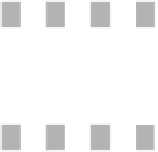Biology Reference
In-Depth Information
Primordial form of
CHC1
gene
Duplications and mutations
Seven repeated structures
Insertion
Number of exon
Present form of
CHC1
gene
6
7
8
9
10
11
12
13
14
CHC1 protein
No. of repeat
I
II
III
IV
V
VI
VII
N-terminal
Repeat unit
Figure 8.12.
Structure and evolution of the human
CHC1
gene (after Furuno
et al
., 1991).
(
CP
; 3q23-q25) consists of three homologous repeat units and appears to have
evolved by successive duplication of a primordial copper-binding protein domain
of ~350 amino acid residues (Ortel
et al
., 1984). Finally, the human annexin II
(
ANX2
; 15q21-q22) gene encodes a protein containing 8 copies of a conserved 70
amino acid repeat (Spano
et al
., 1990).
Exon duplication/amplification is clearly a common mechanism of evolution-
ary change and its occurrence may often be inferred from studies of exon/intron
distribution or from the repetitivity of protein domains (Chapter 3, section 3.6).
Thus, the six paralogous genes of the human salivary proline-rich protein family,
closely linked on chromosome 12p13.2, differ from each other in terms of the
number of copies of a 63 bp tandem repeat in exons 3 of the gene:
PRH1
and
PRH2
(6 repeats),
PRB1
and
PRB3
(15 repeats),
PRB2
(16 repeats) and
PRB4
(11 repeats) (Azen
et al
., 1987; Kim
et al
., 1993). Examples of orthologous gene
pairs in which only one orthologue manifests exon duplication/amplification are
somewhat rarer. The oxidized low density lipoprotein receptor 1 (
OLR1
; 12p12.3-
p13.1) gene serves to illustrate the principle; the rat
Olr1
gene encodes three 46
amino acid repeats between the transmembrane and lectin-like domains of the
LOX-1 protein, whilst the human and bovine
OLR1
genes encode only one such
repeat (Nagase
et al
., 1998).
The primate semenogelin genes (
SEMG1
,
SEMG2
) which, in human, are
closely linked on 20q12-q13.1, encode the major protein constituents of the sem-
inal fluid. These genes differ however between species as a result of internal dupli-
cations of ~180 bp segments encoding 60 amino acid repeats. Human
semenogelin II contains two fewer repeats than rhesus monkey semenogelin II















